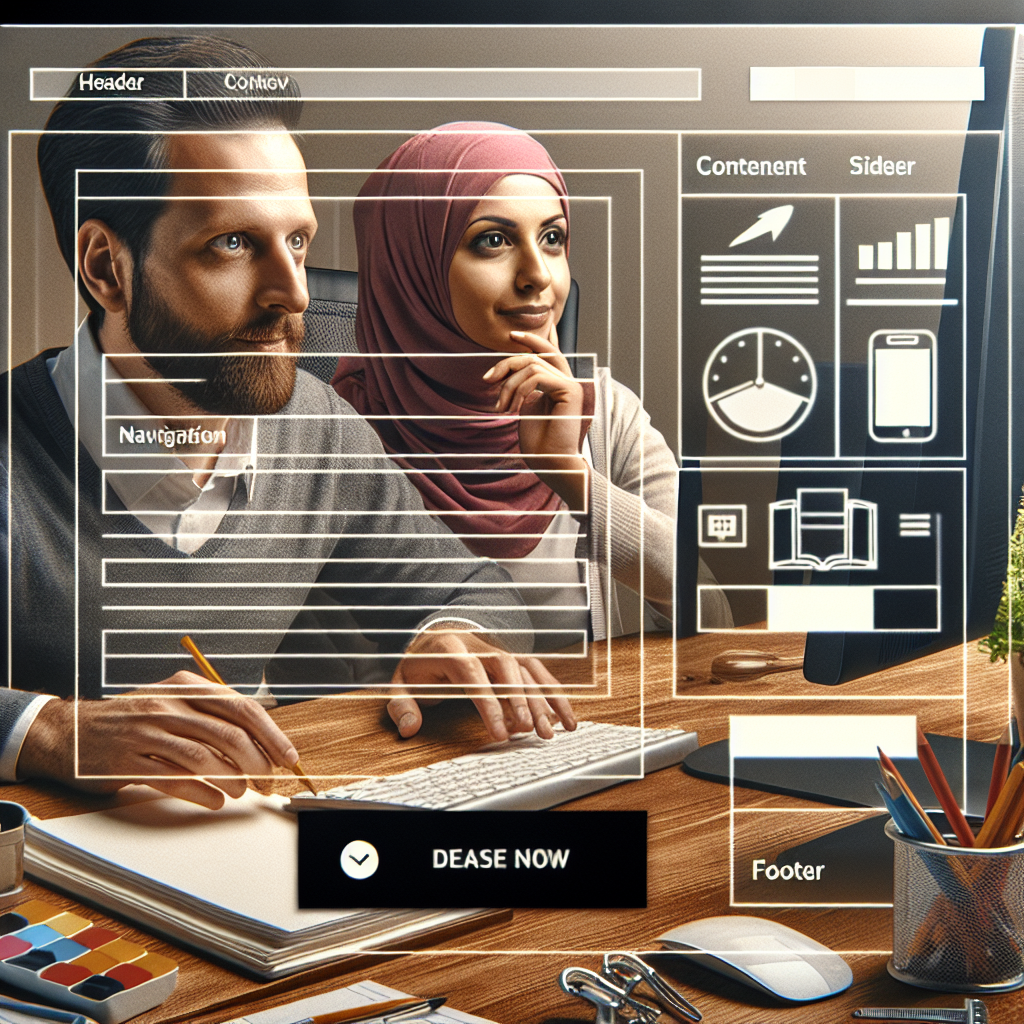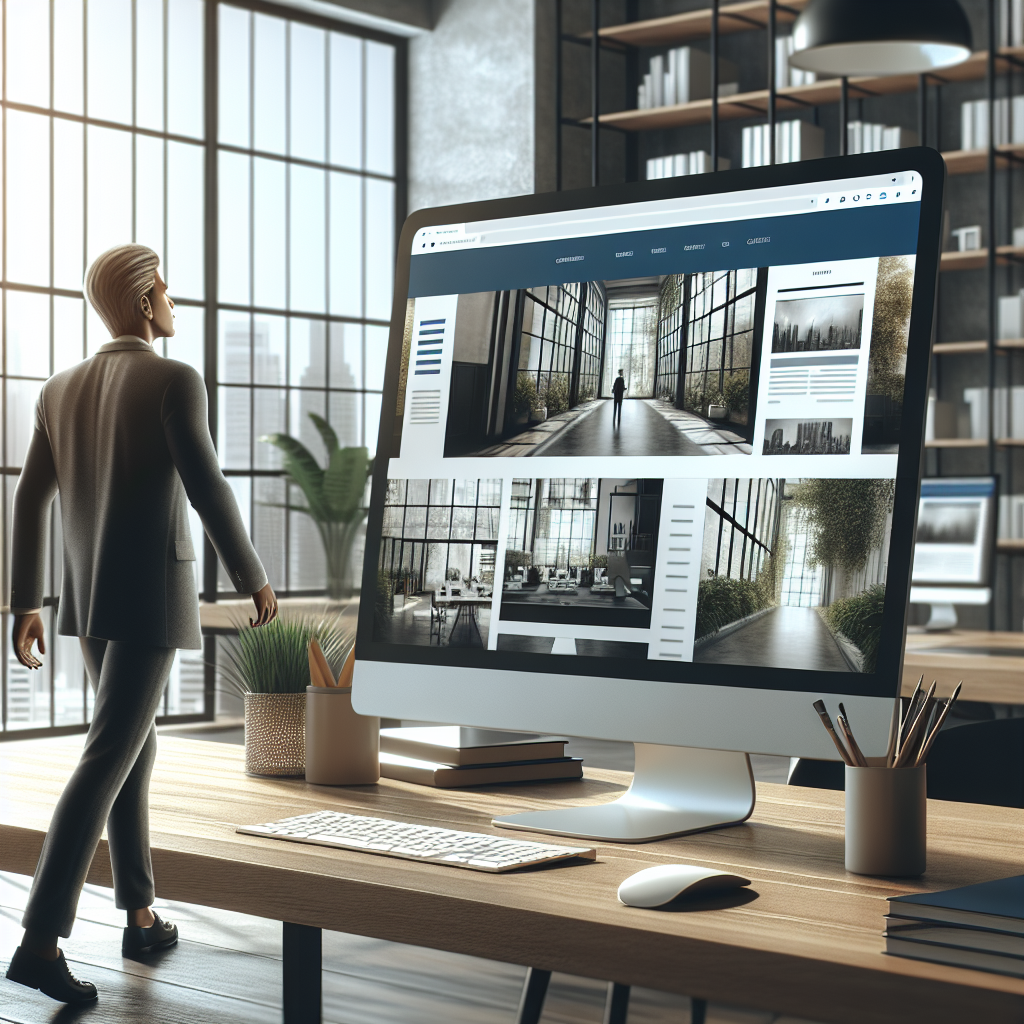Unlocking the Best Website Layouts: Essential Elements and How to Choose the Right Designs for Your Business
What Types of Website Layouts Are There? Discover the Essentials!

When creating a website, one of the most crucial decisions youll make is choosing the right layout. But what types of website layouts are there? The layout can significantly impact how users interact with your site and ultimately decide if they want to engage with your services. Let’s dive into the various layouts that cater to different needs and industries. ⭐
1. The Classic Grid Layout
The grid layout is one of the most popular designs, especially for information-heavy websites. It uses a clean, structured format of rows and columns that organize content neatly. This layout is perfect for catalog websites or blogs, allowing users to scan information quickly. For instance, an online store showcasing multiple products can efficiently use a grid layout to present each item attractively and clearly.
2. Full-Width Layout
If you want to make a strong visual impact, the full-width layout is a great option. This layout stretches across the entire width of the page, often using high-resolution images or videos. For example, a creative agency can utilize this layout to display stunning portfolio pieces, drawing users attention immediately. Additionally, this layout is highly effective for landing pages designed to convert visitors into leads! ⭐
3. F-Layout
The F-layout is based on how people naturally read online, making it a strategic choice for maximizing user engagement. Key content resides in an "F" shape, where the eyes move from left to right at the top and then down vertically. This layout works wonders for articles and e-commerce sites where users need to find products or information easily. Think of how many website support packages rely on quick navigation—this layout can enhance that experience!
4. Single Column Layout
Ideal for blogs and mobile devices, a single-column layout brings simplicity to the forefront. It allows content to flow seamlessly, perfect for storytelling or long reads. This layout is user-friendly, ensuring that visitors can scroll through content without distractions. Many personal blogs thrive with this design due to its focused reading experience. ⭐
5. Asymmetrical Layout
This daring design breaks conventional grid patterns, featuring various sized blocks. An asymmetrical layout can provide a modern touch and help highlight key visuals or messages. It’s often used by tech startups looking to portray innovation. Imagine an app development business setting itself apart with an irregular layout that tells its unique story! ⚡
6. Card Layout
The card layout has gained popularity with platforms like Pinterest. It involves displaying content blocks in a card format, making it easy for users to digest information at a glance. This layout works great for portfolios or social media platforms, where users can quickly browse through different posts or articles. Its versatile and adapts well to various content types!
Table of Layout Comparisons
| Layout Type | Ideal For | Key Features |
| Classic Grid | Catalog Websites | Structured, organized |
| Full-Width | Creative Agencies | High-impact visuals |
| F-Layout | Articles, E-Commerce | Natural reading flow |
| Single Column | Blogs | Simplified storytelling |
| Asymmetrical | Tech Startups | Innovative look |
| Card Layout | Portfolios, Social Media | Breezy browsing |
Why Choose the Right Layout?
Choosing the right website layout not only enhances user experience but also supports your brand’s identity. With our professional specialists at Zuniweb Studio, we can help you select and implement the best layout based on your goals. For over 20 years, we’ve successfully delivered tailored solutions for businesses like yours! Whether its a landing page development on Wordpress or a complete website redesign, we have all your needs covered in one place. ⭐
If you’re ready to elevate your online presence with a compelling layout, don’t hesitate to contact us at Go Telegram Chat or visit us at zuniweb.com. Let’s build something amazing together! ✨
Frequently Asked Questions
- What types of website layouts are there?
There are several layouts, including grid, full-width, F-layout, single column, asymmetrical, and card layouts. - What does a website layout consist of?
It consists of elements like headers, footers, navigation menus, content areas, and images. - What is included in a website layout?
A website layout includes a combination of design elements that organize content effectively. - How to choose the right website layout?
Consider your audience, the type of content you’re presenting, and your brand identity. - How does layout affect user experience?
A well-designed layout guides users’ attention and improves their ability to find information quickly. - Is mobile compatibility important in website layout?
Absolutely! A mobile-friendly layout caters to users visiting from smartphones and tablets. - Can I change my website layout later?
Yes, you can redesign your layout as your business needs and user preferences evolve. - What layout works best for e-commerce sites?
Grid and full-width layouts are effective for showcasing products. - Will my layout choice affect SEO?
Yes, a well-structured layout can improve SEO by making it easier for search engines to index your content. - How can Zuniweb Studio help me with my website layout?
We offer expert consultation and customized designs tailored to your business needs.
What Does a Website Layout Consist Of? Understanding Core Components
contact us
Game apps can be really expensive to build and maintain, but don’t worry, we do everything in our mix to ensure that you get the best, for the best cost.

When it comes to constructing a website, understanding what makes up a layout is crucial for delivering an effective online experience. So, what exactly does a website layout consist of? Let’s break down the essential components that form the backbone of any website layout. Knowing the anatomy of a layout not only helps you as a business owner but also allows you to communicate your vision to developers like us at Zuniweb Studio. ⭐
1. Header
The header is the very first thing visitors see when they land on your website. Its like your digital handshake! This section typically contains the logo, site title, and navigation links. An effective header is crucial as it sets the tone for user interaction and directly influences navigation. For instance, imagine landing on an online store without a clear header—confusing, right? By keeping your header clean and simple, users can easily find their way around without hassle.
2. Navigation Menu
Your navigation menu is a critical part of the website layout. It guides users to different sections of your site, making it easy for them to find what they’re looking for. A user-friendly navigation menu saves time and ensures a smooth browsing experience. Consider using dropdown menus for multi-tier content, allowing for easy access without overcrowding your header. This is especially important for complex sites like service providers offering a wide range of website support packages. ⭐️
3. Main Content Area
This is where the magic happens! The main content area displays your website’s core information—what you want your visitors to see and interact with. This could include texts, images, videos, and interactive elements. For example, a portfolio website should focus on showcasing projects with high-quality visuals to attract potential clients. Remember, keep the content engaging and organized; you want to captivate your audience as soon as they scroll down!
4. Sidebar
Not every site will use a sidebar, but when present, it serves as an excellent complement to the main content area. Sidebars can contain additional navigation, recent posts, newsletters, or ads. Think of them as a guidepost—helping users discover more of your content. For a blog about technology, placing social media links or related articles can drive user engagement. ⭐
5. Footer
Your footer is the final piece of the puzzle, providing essential information about your website. It typically includes copyright notices, links to privacy policies, and contact information. A well-organized footer can enhance user trust and ensure that vital information isn’t overlooked. You might even include links to your social media accounts here—a quick way to connect with your audience! ⭐
6. Call-to-Action (CTA)
CTAs are critical for driving user action on your site. Whether its signing up for a newsletter, requesting a quote, or purchasing a product, having clear CTAs embedded in your layout can significantly improve conversion rates. A poorly placed or unclear CTA can feel like a missed opportunity. For example, if you’re offering landing page development services, a bold “Get Started Today” button can direct visitors toward taking immediate action. Don’t underestimate the power of a compelling CTA!
Table of Website Layout Components
| Component | Purpose |
| Header | Initial navigation and branding |
| Navigation Menu | Guides users to different sections |
| Main Content Area | Core information and interaction |
| Sidebar | Additional links and info |
| Footer | Essential details and trust signals |
| Call-to-Action (CTA) | Encourages user action |
Why Understanding Layout Components Matters
Each of these components plays a pivotal role in shaping your websites overall effectiveness. At Zuniweb Studio, with over 20 years of experience, our expert team understands how to strategically integrate these elements to create cohesive and successful layouts that not only look good but also convert visitors into customers. Remember, a well-designed website can enhance user trust and satisfaction, leading to better business results. ✨
If you’re ready to take your website to the next level or need help designing the right layout for your needs, don’t hesitate to reach out! Call us at Go Telegram Chat or visit us at zuniweb.com. Let’s build something amazing together! ⭐
Frequently Asked Questions
- What does a website layout consist of?
A website layout consists of components such as headers, navigation, content areas, sidebars, footers, and call-to-action buttons. - What is the purpose of a header?
The header provides branding and offers navigation options for the visitor right away. - Are sidebars necessary?
Sidebars arent mandatory but can improve user engagement by providing additional navigation or content. - What should I include in a footer?
A footer typically includes copyright information, contact details, and links to social media or privacy policies. - What is a call-to-action?
A call-to-action (CTA) is a prompt that encourages users to take specific actions, like signing up or purchasing. - How can I improve my website layout?
Consider user experience; optimize navigation, enhance content presentation, and use clear CTAs. - Can layout impact SEO?
Yes, an organized layout allows for better indexing by search engines, improving your visibility. - What is a navigation menu?
The navigation menu helps users find different sections of your site; it is critical for user experience. - What should I consider when designing my layout?
Think about your audience, the types of content youll display, and your overall brand positioning. - How can Zuniweb Studio help with my website design?
We offer customized solutions and expert advice to create a perfect layout for your website needs.
How to Choose the Right Website Layout? A Guide to Optimal User Experience
contact us
Game apps can be really expensive to build and maintain, but don’t worry, we do everything in our mix to ensure that you get the best, for the best cost.

Choosing the right website layout can feel like a daunting task, but it’s one of the most crucial factors in ensuring a top-notch user experience. So, how do you select a layout that not only meets your business objectives but also keeps your visitors engaged? Lets explore some practical tips and insights you can use in making that decision! ⭐️
1. Understand Your Objectives
The very first step in choosing a layout is to clarify your objectives. Are you looking to generate leads, sell products, or provide information? Each goal may require a different layout. For example, if your aim is to sell products, an e-commerce layout with a grid format showcasing multiple items would work best. Conversely, if you want to share information or articles, a single-column layout might suit your needs more effectively.
2. Know Your Audience
Understanding who your audience is can vastly influence your layout choice. Are they tech-savvy millennials or older generations who prefer traditional designs? Different demographics may respond better to different layouts. A young audience might enjoy a more dynamic and colorful interface, while older users might prefer something simple and straightforward. Always consider user preferences and behaviors to enhance the experience! ⭐
3. Focus on Usability
Your layout should prioritize usability. Ensure that the navigation is straightforward and intuitive. A well-organized menu that guides users without them having to think too much will engage them better. Statistics show that 88% of online consumers are less likely to return to a site after a bad experience. This emphasizes the importance of an accessible and user-friendly layout! Keep your design clean, with a good balance of text and images, making it easy for visitors to find what they’re looking for.
4. Responsive Design is a Must
In our mobile-centric world, ensure your layout is responsive, meaning it works well on various devices, especially smartphones and tablets. A layout that fails to adapt to different screen sizes can frustrate users and drive them away. According to a recent study, 61% of users are unlikely to return to a mobile site they had trouble accessing. To avoid making this mistake, engage a company skilled in website redesign to create a responsive layout for your business! ⭐
5. Test and Iterate
Choosing a layout is not a one-and-done deal. It’s vital to continuously test your website layout to see how users interact with it. Use A/B testing to try out different layouts and see what works best for your audience. Monitor user behavior and engagement metrics. Are people leaving at a certain point? Adjust accordingly! Small changes can lead to significant improvements in user experience, boosting both retention and conversions.
6. Seek Expert Guidance
If you’re overwhelmed with choices, don’t hesitate to seek professional help. At Zuniweb Studio, our team of specialists boasts over 20 years of experience in creating effective website layouts tailored to diverse business needs. Whether you’re looking for a business card website development or a robust online store, we’ll help navigate the complexities of layout selection to ensure your site meets user needs while achieving business goals. ⭐
Table of Considerations for Choosing a Layout
| Consideration | Importance |
| Your Objectives | Guides layout choice for specific business needs |
| Audience Research | Informs design preferences and behaviors |
| Usability | Improves user satisfaction and engagement |
| Responsive Design | Enhances accessibility across various devices |
| Continuous Testing | Allows for iterative improvements |
| Expert Consultation | Ensures your layout aligns with best practices |
Why the Right Layout Matters
The right website layout can mean the difference between a user lingering on your site and bouncing away. It affects not only user perception but also shapes functionality and ultimately drives conversions. Treat your website layout as an investment in user experience; you’ll reap the rewards in customer satisfaction and loyalty. If you’re unsure of where to start, our team is ready to guide you every step of the way.
If you’re eager to choose the best layout for your website and take your online presence to the next level, contact us today at Go Telegram Chat or visit zuniweb.com. Let’s create something remarkable together! ⭐
Frequently Asked Questions
- How do I know which layout is best for my site?
Begin by identifying your business objectives and understand your audiences preferences. - Is usability really that important?
Yes! A user-friendly layout ensures visitors have a positive experience, increasing the likelihood of return visits. - What does ‘responsive design’ mean?
Responsive design ensures your website adjusts seamlessly for various devices, improving accessibility and usability. - Can I change my layout later?
Absolutely! It’s essential to adapt your layout based on user feedback and functionality needs. - What are some common mistakes when choosing a layout?
Focusing solely on aesthetics over functionality, not considering mobile responsiveness, and neglecting user testing are common pitfalls. - How can I test my website layout?
Utilize A/B testing to gauge user interactions with different layouts and analyze engagement metrics. - Is expert advice worth it?
Yes! Experienced professionals can provide insights that save time and enhance the usability and aesthetic of your site. - Why is it crucial to consider my objectives?
Clear objectives direct your layout choice, ensuring it supports your business goals effectively. - Can Zuniweb Studio help with layout selection?
Yes! Our team specializes in understanding client needs and tailoring layouts to meet specific requirements. - What can I do if my users are bouncing off my site?
Assess your layout, content, and navigation to identify areas of improvement and make necessary adjustments.
Common Myths About Website Layouts: Debunking Misconceptions for Better Choices
contact us
Game apps can be really expensive to build and maintain, but don’t worry, we do everything in our mix to ensure that you get the best, for the best cost.

When it comes to designing your website, misinformation can lead to misguided decisions. Many people have preconceptions about web layouts that can impair their ability to create a user-friendly experience. In this chapter, we’ll debunk some common myths about website layouts to help you make better choices for your online presence! ⭐
1. Myth: More Features Mean a Better Layout
It’s a common belief that cramming in as many features, buttons, and sections as possible will enhance a layout. However, this can often lead to a cluttered interface that overwhelms users. In fact, simplicity is key! A clean, organized layout allows visitors to focus on what really matters. Imagine walking into a store packed to the brim with products—confusing, right? A minimal layout can guide users effectively, making for a better experience. So, when designing, prioritize functionality over excessive features!
2. Myth: All Layouts Work the Same for Every Business
Another misconception is that one size fits all when it comes to website layouts. In reality, different businesses have unique needs and audiences. For example, an online store may need a grid layout showcasing products, while a service provider may benefit more from a single-column approach that emphasizes client testimonials and case studies. Your layout should reflect your brand’s goals and cater specifically to your target audience. Research shows that 74% of users are more likely to return to a site that is tailored to their preferences.
3. Myth: Once You Choose a Layout, It’s Set in Stone
Many believe that once a layout is chosen, it cannot be changed. However, your website should evolve as your business grows and technology advances. Regularly assessing user behavior and feedback can help inform necessary updates. An iterative approach allows you to refine the layout over time, ensuring it remains effective and fresh. A/B testing can even reveal which layout version performs better, giving you the data needed to make informed decisions. ⭐
4. Myth: Aesthetics Are All That Matters
While a visually appealing website layout can attract visitors, it isn’t enough on its own. Usability and functionality are just as critical to ensure visitors can navigate easily and find what they need. A beautiful site that is hard to use will drive users away. Aim for a balance between aesthetics and practicality—think about your visitors’ journey from the moment they land on your site. Providing a straightforward, engaging experience will keep them coming back. ⭐
5. Myth: All Users Are Tech-Savvy
Its easy to assume that everyone visiting your website is comfortable with technology. In reality, users have varying levels of proficiency, and your site should cater to everyone—especially those who might not be as tech-savvy. Keeping layouts straightforward and navigation intuitive will enhance accessibility for all users. Remember, a significant portion of consumers values simplicity over complexity! Approximately 68% of users are more likely to engage with a website that is easy to understand.
6. Myth: SEO Doesn’t Depend on Layout
Some business owners underestimate the relationship between website layout and Search Engine Optimization (SEO). The truth is, a well-structured layout enhances SEO performance by improving page indexing and ensuring content is accessible for both users and search engines. Proper use of headings, clear navigation, and optimized images not only improve user experience but also boost your visibility in search results. Investing in a thoughtful layout can bring significant ROI for your business. ⭐
Table of Common Myths About Website Layouts
| Myth | Truth |
| More features = better layout | Simplicity enhances usability |
| One layout fits all | Layouts must cater to specific business needs |
| Chosen layout is permanent | Layouts can be updated regularly |
| Aesthetics are all that matters | Balance between beauty and usability is essential |
| All users are tech-savvy | Layouts must cater to users of all skill levels |
| SEO ignores layout | Well-structured layouts enhance SEO |
Making Informed Layout Choices
Understanding and debunking these myths can greatly enhance your decision-making process when it comes to website layouts. Remember, a well-chosen layout not only improves user experience but also drives engagement and conversions. At Zuniweb Studio, we’re here to help ensure that your website not only looks fantastic but also serves its purpose effectively. ⭐
If you’re ready to discuss your website’s layout or need expert guidance, don’t hesitate to reach out to us at Go Telegram Chat or visit zuniweb.com. Let’s create a website that sets you apart! ⭐
Frequently Asked Questions
- What are some common myths about website layouts?
Common myths include the belief that more features make better layouts, all layouts are universally applicable, layouts cannot change, aesthetics are the only consideration, and that SEO is unrelated to layout. - Why is simplicity important in layouts?
A simple layout allows users to find information quickly, reducing frustration and improving user retention. - Can a website layout evolve over time?
Yes! Regular updates based on user feedback and data analysis are vital for continuous improvement. - Is usability as important as aesthetics?
Absolutely! A functional and easy-to-navigate layout is essential for keeping visitors engaged. - How can I better understand my audiences needs?
Conduct user research, surveys, and analyze data to uncover preferences and behaviors. - How does layout impact SEO?
A well-structured layout aids in content indexing and enhances visibility in search engine results. - Are all users comfortable with technology?
No, users have varied levels of tech proficiency, which the layout should accommodate. - What should I prioritize when selecting a layout?
Prioritize clarity, usability, responsiveness, and your specific business objectives. - Can Zuniweb Studio assist in choosing the right layout?
Yes! Our team is experienced in creating effective layouts tailored to your business needs. - What should I consider to improve user experience?
Focus on a balance between aesthetics and usability, streamline navigation, and implement regular updates based on user feedback.

Currently under development

Heroes Infinity: RPG + Strategy + Super Heroes
An epic action RPG packed with heroes, battles, and boundless adventure. Dive into the captivating world of Heroes of Infinity and embark on an unforgettable journey through cities and distant lands. Recruit powerful heroes, battle relentless enemies, and build your ultimate legendary team.
Experience seamless gameplay and captivating challenges. We blend smooth mechanics with dynamic pacing to ensure your adventure never slows down. Dive into an immersive world where every move matters — with rich visuals, responsive controls, and battles that push your strategy and skills.
RPG
mobile
strategy
Unity 3D